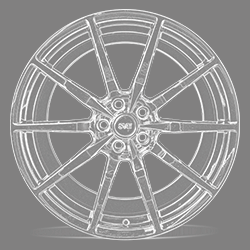Androdz
Banned
This is about all the VVT systems on the market. This write up was done by a friend of mine from information taken from books, websites and other forums.
The first time that VVT(variable valve timing) appeared was with the multi valve engines. The auto manufacturers invented the next step in getting more hp from engines. The theory is that valves control the ammount of air that goes in and out in the engine. Obviosly what controls the valves are the camshafts (or the camshaft on a SOHC). That way if they can be controlled, then the ammount of air that goes in the engine can be controlled aswell.
On a conventional engine when you increase revolutions the duration of intake and exhaust stroke decrease. So it is more difficult for the air to enter the combustion chamber and it is also more difficult to exit as well. So it basically chokes and stops producing. The best way to combat this is to open the intake valves earlier and closing the exhaust valves later. This is called overlap. So in other words the more you rev the more overlap you should have.
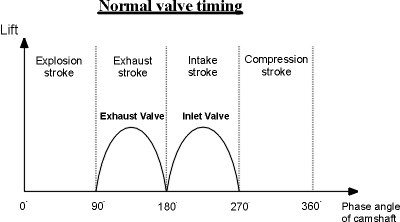
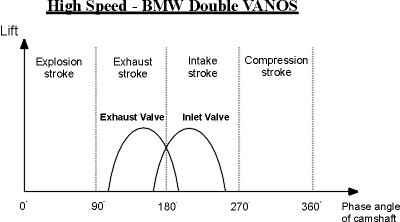
Without VVT the manufacturers could only select a camshaft that has a good idle and not a not so good high power band. What happens is that if you use a camshaft with a lot of overlap, the car will fault on low revs and consume extra gasoline. In the end a manufacturer will not do a design like that because the general population doesn't like the big lope of some big cams on idle. (Regretably not everyone is a car freak)
So to avoid that, the manufacturers had a ingenous idea; VVT. With VVT the power and torque can be optimized across the entire powerband, engines can rev more. Everyone knows what can happen when you rev more
For example:
A nissan engine (SR20VE) increases its power by 25% comparing it with a SR20DE normal. With vvt one can increase the low end torque, High end, finally on any part of the powerband.
Ok lets talk about the systems of different manufactureres.
Honda's Variable Valve Timming with Electronic Lift Control ..
Honda is the pioneer with the version of VVT in production cars. In 1988 the first VVT/V-tec engine was release; the CRX SIR with a B16A 1st generation engine. It was followed by the civic and NSX with the famous Vtec. As the years passed almost every model from honda had it.
The system has various versions; it consists with camshafts that contain various lobes that at a predetermined point shifts to a higher lobe that contain more lift and duration. That way you can have a normal car idle and a top end of a car with racing camshafts. Honda not only makes a motor that has camshafts that with oil pressure moves to a set of more aggressive lobes, if not it designed the entire engine for performance. For example the Heads, compression ect. Remember everything has to be combined to produce. Not only by putting aggressive cams you are going to get good numbers.
This is a 3 stage vtec system
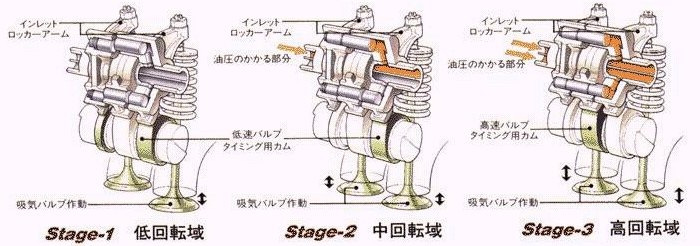
The system has its flaws, for example the system is a bit heavier and complicated if the rocker arms where only like a conventional system. Also outside Vtec they have very low end torque. But that was solved with the I-Vtec which besides changing the lift, it moves the cam gear of the intake to incrase the torque across the entire powerband.
Nissan Neo VVL
It is very similar to the honda system. The differences is that both camshafts have the same profile. At low revs, both rocker arms are guided independently by a low timing and a low lift. At medium and high revs 3 rocker arms connect with each other so they can be moved by the advanced timing and the high lift/duration lobes of the middle camshaft. This way the system instead of being 2 stage (low and high lift) is 3 stage:
Stage 1 (low speed) : Both intake valves and exhaust valves are in slow configuration
Stage 2 (medium speed) : Fast configuration of the intake valves + slow configuration of the exhaust valves
Stage 3 (high speed) : Both intake valves and exhaust valves are in rapid configuration
They are other manufacturers that use systems that change lift- Mitsubishi Mivec, BMW, Toyota VVTL-i, Porsche Variocam Plus
But lets talk about common VVT systems that are in many cars.
This is a list of some of them:
Audi 2.0-litre - continous inlet
Audi 3.0 V6 - continous inlet, 2-stage exhaust
Audi V8 - inlet, 2-stage discrete
BMW Double Vanos - inlet and exhaust, continuous
Ferrari 360 Modena - exhaust, 2-stage discrete
Fiat (Alfa) SUPER FIRE - inlet, 2-stage discrete
Ford Puma 1.7 Zetec SE - inlet, 2-stage discrete
Ford Falcon XR6's VCT - inlet, 2-stage discrete
Jaguar AJ-V6 and updated AJ-V8 - inlet, continuous
Lamborghini Diablo V12 since SV - inlet, 2-stage discrete
Mazda MX-5's S-VT - continous inlet
Mercedes V6 and V8 - inlet, 2-stage ?
Nissan QR four-pot and V8 - continuous inlet
Nissan VQ V6 - inlet, continuous ?
Nissan VQ V6 since Skyline V35 - inlet, electromagnetic
Porsche Variocam - inlet, 3-stage discrete
PSA / Renault 3.0 V6 - inlet, 2-stage
Renault 2.0-litre - inlet, 2-stage discrete
Subaru AVCS - inlet, 2-stage ?
Toyota VVT-i - continuous, mostly inlet but some also exhaust
Volvo 4 / 5 / 6-cylinder modular engines - inlet, continuous
Volkswagen VR6 - inlet, continuous ?
Volkswagen (Audi) W8 and W12 - continuous inlet, 2-stage exhaust
The advantages of a system like that is that it is cheap and increases the power thru the entire powerband. The disadvantages is that since they dont change lift pues they don't have lift and they dont have the top end rush of a v-tec system, neo VVL, Mivec etc.
Basically this systems function moving the cam gears (Advancing and retarding by a number of degrees) For example at high revs the system advances 30 degrees so that the valves open before and increase the overlap. All these movements are controlled by the ECU of the car. Remember that common VVT systems dont alter the lift of the camshafts.
The mayority of the systems to avoid being to complex only have VVT on a single camshaft. BMW and its double vanos has it on both. This permits it to controll the valves very well, even though it does not increase lift; they can put camshafts with a lot of overlap and control them by the camgears so that they can have a nice idle. But obviously up to a certain extent, the time will come that you will need more lift and duration. For example on the bmw M3 E46 the double vanos moves the camgear of the intake 40 degrees on both dirrections and the exhaust can only be moved 25 degrees.
Sistema BMW VANOS
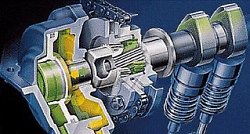
Sistema Toyota VVT-i
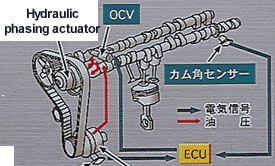
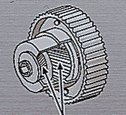
Sistema Porsche Variocam plus
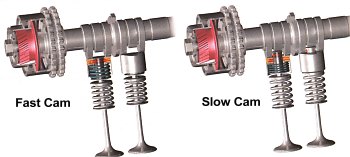
Variocam Plus uses a hydralic system on top of the valves to increase lift and duration that the valves see.
Another advantage of the vvt is that it lowers emissions.
The first time that VVT(variable valve timing) appeared was with the multi valve engines. The auto manufacturers invented the next step in getting more hp from engines. The theory is that valves control the ammount of air that goes in and out in the engine. Obviosly what controls the valves are the camshafts (or the camshaft on a SOHC). That way if they can be controlled, then the ammount of air that goes in the engine can be controlled aswell.
On a conventional engine when you increase revolutions the duration of intake and exhaust stroke decrease. So it is more difficult for the air to enter the combustion chamber and it is also more difficult to exit as well. So it basically chokes and stops producing. The best way to combat this is to open the intake valves earlier and closing the exhaust valves later. This is called overlap. So in other words the more you rev the more overlap you should have.


Without VVT the manufacturers could only select a camshaft that has a good idle and not a not so good high power band. What happens is that if you use a camshaft with a lot of overlap, the car will fault on low revs and consume extra gasoline. In the end a manufacturer will not do a design like that because the general population doesn't like the big lope of some big cams on idle. (Regretably not everyone is a car freak)
So to avoid that, the manufacturers had a ingenous idea; VVT. With VVT the power and torque can be optimized across the entire powerband, engines can rev more. Everyone knows what can happen when you rev more
For example:
A nissan engine (SR20VE) increases its power by 25% comparing it with a SR20DE normal. With vvt one can increase the low end torque, High end, finally on any part of the powerband.
Ok lets talk about the systems of different manufactureres.
Honda's Variable Valve Timming with Electronic Lift Control ..
Honda is the pioneer with the version of VVT in production cars. In 1988 the first VVT/V-tec engine was release; the CRX SIR with a B16A 1st generation engine. It was followed by the civic and NSX with the famous Vtec. As the years passed almost every model from honda had it.
The system has various versions; it consists with camshafts that contain various lobes that at a predetermined point shifts to a higher lobe that contain more lift and duration. That way you can have a normal car idle and a top end of a car with racing camshafts. Honda not only makes a motor that has camshafts that with oil pressure moves to a set of more aggressive lobes, if not it designed the entire engine for performance. For example the Heads, compression ect. Remember everything has to be combined to produce. Not only by putting aggressive cams you are going to get good numbers.
This is a 3 stage vtec system

The system has its flaws, for example the system is a bit heavier and complicated if the rocker arms where only like a conventional system. Also outside Vtec they have very low end torque. But that was solved with the I-Vtec which besides changing the lift, it moves the cam gear of the intake to incrase the torque across the entire powerband.
Nissan Neo VVL
It is very similar to the honda system. The differences is that both camshafts have the same profile. At low revs, both rocker arms are guided independently by a low timing and a low lift. At medium and high revs 3 rocker arms connect with each other so they can be moved by the advanced timing and the high lift/duration lobes of the middle camshaft. This way the system instead of being 2 stage (low and high lift) is 3 stage:
Stage 1 (low speed) : Both intake valves and exhaust valves are in slow configuration
Stage 2 (medium speed) : Fast configuration of the intake valves + slow configuration of the exhaust valves
Stage 3 (high speed) : Both intake valves and exhaust valves are in rapid configuration
They are other manufacturers that use systems that change lift- Mitsubishi Mivec, BMW, Toyota VVTL-i, Porsche Variocam Plus
But lets talk about common VVT systems that are in many cars.
This is a list of some of them:
Audi 2.0-litre - continous inlet
Audi 3.0 V6 - continous inlet, 2-stage exhaust
Audi V8 - inlet, 2-stage discrete
BMW Double Vanos - inlet and exhaust, continuous
Ferrari 360 Modena - exhaust, 2-stage discrete
Fiat (Alfa) SUPER FIRE - inlet, 2-stage discrete
Ford Puma 1.7 Zetec SE - inlet, 2-stage discrete
Ford Falcon XR6's VCT - inlet, 2-stage discrete
Jaguar AJ-V6 and updated AJ-V8 - inlet, continuous
Lamborghini Diablo V12 since SV - inlet, 2-stage discrete
Mazda MX-5's S-VT - continous inlet
Mercedes V6 and V8 - inlet, 2-stage ?
Nissan QR four-pot and V8 - continuous inlet
Nissan VQ V6 - inlet, continuous ?
Nissan VQ V6 since Skyline V35 - inlet, electromagnetic
Porsche Variocam - inlet, 3-stage discrete
PSA / Renault 3.0 V6 - inlet, 2-stage
Renault 2.0-litre - inlet, 2-stage discrete
Subaru AVCS - inlet, 2-stage ?
Toyota VVT-i - continuous, mostly inlet but some also exhaust
Volvo 4 / 5 / 6-cylinder modular engines - inlet, continuous
Volkswagen VR6 - inlet, continuous ?
Volkswagen (Audi) W8 and W12 - continuous inlet, 2-stage exhaust
The advantages of a system like that is that it is cheap and increases the power thru the entire powerband. The disadvantages is that since they dont change lift pues they don't have lift and they dont have the top end rush of a v-tec system, neo VVL, Mivec etc.
Basically this systems function moving the cam gears (Advancing and retarding by a number of degrees) For example at high revs the system advances 30 degrees so that the valves open before and increase the overlap. All these movements are controlled by the ECU of the car. Remember that common VVT systems dont alter the lift of the camshafts.
The mayority of the systems to avoid being to complex only have VVT on a single camshaft. BMW and its double vanos has it on both. This permits it to controll the valves very well, even though it does not increase lift; they can put camshafts with a lot of overlap and control them by the camgears so that they can have a nice idle. But obviously up to a certain extent, the time will come that you will need more lift and duration. For example on the bmw M3 E46 the double vanos moves the camgear of the intake 40 degrees on both dirrections and the exhaust can only be moved 25 degrees.
Sistema BMW VANOS

Sistema Toyota VVT-i


Sistema Porsche Variocam plus

Variocam Plus uses a hydralic system on top of the valves to increase lift and duration that the valves see.
Another advantage of the vvt is that it lowers emissions.
Last edited:


 You forgot to mention it's for small, gay engines.
You forgot to mention it's for small, gay engines.
